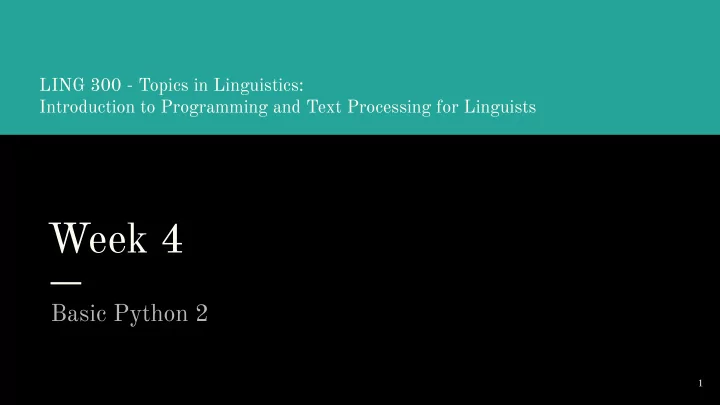

LING 300 - Topics in Linguistics: Introduction to Programming and Text Processing for Linguists Week 4 Basic Python 2 1
Notes from Assignment 3 Biggest thing: please make sure your assignment runs all the way through on Quest! 2
Notes from Assignment 3 ● Meaningful variable names! ● Core ways to read files: for line in open(f): vs text = open(f).read() ● You can do operations in defining `for` loops, e.g.: for word in s.split(): ● continue statement in loops 3
Scope determines where objects are defined # `print` is built-in print('hi!') # non-indented is global my_var = ‘helloooo’ def my_func(): # only available # inside the function local_var = 'hey?' # gets NameError print(local_var) 4 https://www.geeksforgeeks.org/namespaces-and-scope-in-python/
Sets are unordered collections of unique elements Analogous to sets in math, lists of unique items https://www.datacamp.com/community/tutorials/sets-in-python 5
Set Methods s = set() # create an empty set s.add(val) # add a value to the set s.remove(val) # remove a value from the set s1 & s2 # set intersection s1 - s2 # set difference s1.issubset(s2) # set operations s1.issuperset(s2) s1.union(s2) s1.intersection(s2) len(s) # number of items in the set 6
Dictionaries define key-value mappings Versatile mappings between whatever and whatever https://developers.google.com/edu/python/dict-files 7
Dictionary Methods d = {} # create an empty dictionary and assign it to d d[key] = value # assign a value to a given dictionary key d.keys() # the list of keys of the dictionary d.values() # the list of values in the dictionary if key in d: # test whether a particular key is in the dictionary for key in d: # iterate over the keys of the dictionary len(d) # number of keys in the dictionary 8
Random Built-in Module ● We’ll use it a lot in this assignment! random.random() with nested conditionals: randval = random.random() # float between 0 and 1 if randval < 0.35: # 35% chance of entering here elif randval < 0.6: # 25% chance of entering here else: # 40% chance of entering here 9
Recommend
More recommend